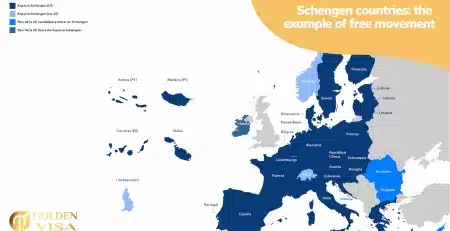Spain has long been a popular destination for holiday home buyers from northern Europe and beyond. With its sunny Mediterranean coastline, low cost of living, and laidback lifestyle, owning property in Spain holds huge appeal. House hunters are spoiled for choice when it comes to beautiful locations and affordable prices.
But how do Spanish house prices really compare to other major European property markets? And which regions within Spain are the most expensive? Let’s dive into the data and see what we can learn.
How much are the housing Prices in Spain?
During the 2000s property bubble, Spanish house prices skyrocketed, with massive construction driving supply. When the global financial crisis hit, the market came crashing down. Prices fell as much as 50-60% in some parts of the country.
However, the market finally bottomed out around 2013. Over the last decade, house prices in Spain have been rising again, buoyed by economic recovery and low interest rates. That said, property in Spain is still cheaper than it was 15 years ago when adjusted for inflation.
According to official statistics, the average price per square meter for residential property in Spain at the end of 2020 was €1,639. This figure of course masks huge regional variations. Major cities like Madrid (€3,011) and Barcelona (€4,251) are far pricier than rural areas.
Coastal Regions Are the Most Expensive
When analyzing average house prices across Spain, coastal regions take the top spots on the list:
- Basque Country – €2,122 per m2
- Balearic Islands (Majorca, Ibiza) – €2,115 per m2
- Catalonia (Barcelona) – €1,965 per m2
- Valencia Region – €1,365 per m2
- Andalusia (Malaga) – €1,306 per m2
Besides thePull of the ocean and beaches, these areas benefit from strong tourism and foreign buyer interest. Limited housing supply also drives up prices near the coasts.
In contrast, Spain’s interior regions have lower property values:
- Castilla y León – €1,077 per m2
- Extremadura – €845 per m2
- Castilla La Mancha – €805 per m2
So while certain prime coastal zones carry premium price tags, there are still deals to be found across inland Spain.
How houses Prices in Spain Compare to Europe
Spain remains one of the cheapest countries in Western Europe for property. According to Eurostat data, it ranks below the EU average for house prices.
As of 2020, average residential property prices around Europe were:
- Luxembourg – €6,744 per m2
- Netherlands – €3,375 per m2
- Denmark – €3,309 per m2
- France – €3,172 per m2
- Finland – €2,922 per m2
- Sweden – €2,869 per m2
- Germany – €2,755 per m2
- Belgium – €2,412 per m2
- Austria – €2,231 per m2
- Spain – €1,639 per m2
Clearly property in Spain is still quite affordable compared to northern Europe. Prices are around half what they are in the Netherlands, for example.
But Spanish real estate looks expensive next to eastern European countries like:
- Bulgaria – €1,039 per m2
- Romania – €1,159 per m2
- Hungary – €1,416 per m2
So while not the cheapest in Europe, property in Spain provides better value than most of the continent.

Why Buy a House in Spain?
Given the relatively low prices, what are the advantages of buying property in Spain compared to other European countries?
- Sunny Mediterranean climate: Mild winters and hot summers, with over 300 days of sunshine per year on average. Perfect for a second home.
- Lower cost of living: Goods, services and daily expenses are lower in Spain than much of Europe. Great for retirement.
- Laidback lifestyle: The famous Spanish way of life is relaxed and focused on family, food, and enjoying life.
- Beaches: Spain has over 5,000 km of coastline and amazing beaches from the Costa Brava to the Costa del Sol.
- Healthcare: The Spanish healthcare system ranks highly in Europe, while being free for residents.
- Food and wine: Fresh produce, seafood, olive oil, and of course, excellent local wine. The Mediterranean diet is healthy too.
- Infrastructure: Roads, airports and public transport are modern and efficient throughout the country.
- Culture: Spain has a rich cultural heritage, and colorful festivals year-round.
While other countries offer some of these benefits too, the overall Spanish package is hard to beat. That unique blend of climate, culture, affordability, and quality of life advantage attracts so many expats and second home buyers.
Beckham law and benefits for buying a house in Spain
Spain also provides tax incentives for foreign buyers and retirees. The so-called “Beckham law” offers tax breaks to foreign residents who move to Spain. For the first five years, overseas property owners can claim non-domicile tax status. They pay tax only on Spanish income, not on worldwide earnings. This provides a substantial advantage for the wealthy looking to establish residency in Spain. Retirees also get benefits, like reduced wealth and inheritance tax obligations. Taxes should always be factored into any major real estate purchase decision. But Spain makes it a little easier for foreigners through these types of incentives.
Future outlook
Looking ahead, demand for Spanish property remains strong, while supply is still constrained after construction collapsed during the financial crisis. Low interest rates also sustain affordability.
So further house price appreciation seems likely over the next few years, especially in the most popular coastal markets. Spain’s economy continues recovering from COVID-19 as tourism rebounds too.
For homebuyers seeking an affordable slice of the Mediterranean lifestyle, Spain remains an excellent choice within Europe. The country still offers good value compared to many northern neighbors. Though prices vary by region, there are bargains still available if you avoid the prime areas.
In Apply Golden Visa we help you with the whole process to get your Spanish Golden visa, do not hesitate to contact us.













Leave a Reply